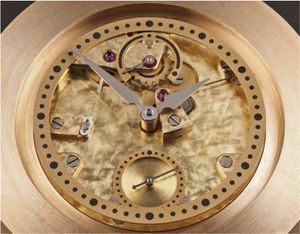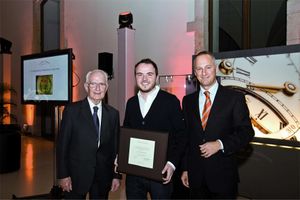F. A. Lange Watchmaking Excellence Award 2011/en
F. A. Lange Watchmaking Excellence Award 2011
Glashütte, December 2011
For the second time, A. Lange & Söhne bestows young talent award for next generation of watchmakers
On 7 December 2011, the “F. A. Lange Watchmaking Excellence Award”, sponsored by A. Lange & Söhne, was presented in Dresden for the second time. The winner of the international competition for young watchmakers is the 23 year-old Suliac Monfort from Lycée Edgar Faure in Morteau, France, who was awarded the 10,000 Euro prize by an expert jury for his construction of a power reserve indication based on a Unitas pocket watch movement. The award was overhanded to Suliac Monfort during an event on the occasion of the company’s anniversary by Walter Lange and Lange-CEO Wilhelm Schmid.
The jury decided unanimously on the design of Suliac Monfort because, in comparison to the other entries, his mechanism found the most creative solution with a highly functional design, as well as displaying an outstanding level of craftsmanship and artistry. The prize money is specifically awarded for use in advanced watchmaking studies.
In the first round of the competition eight future watchmakers from Germany, Austria, France, Denmark, and the Netherlands qualified for the project from the forty watchmaking schools from all over the world that were invited to participate. They attended a summer workshop in the Lange Watchmaking School to become familiar with the Lange watchmaking philosophy. Following the workshop the participants had three months to construct a functional power reserve mechanism on the basis of a Unitas pocket watch movement.
The extremely sophisticated entries were judged in November by a jury of five experts, including the watch journalists Gisbert L. Brunner and Peter Braun, company founder Walter Lange, Head of Lange’s Product Development Anthony de Haas and Director of the Mathematics and Physics Salon in Dresden Dr Peter Plassmeyer. The judging criteria were innovation and originality of idea, functionality, technical quality and craftsmanship as well as artistic realisation.

